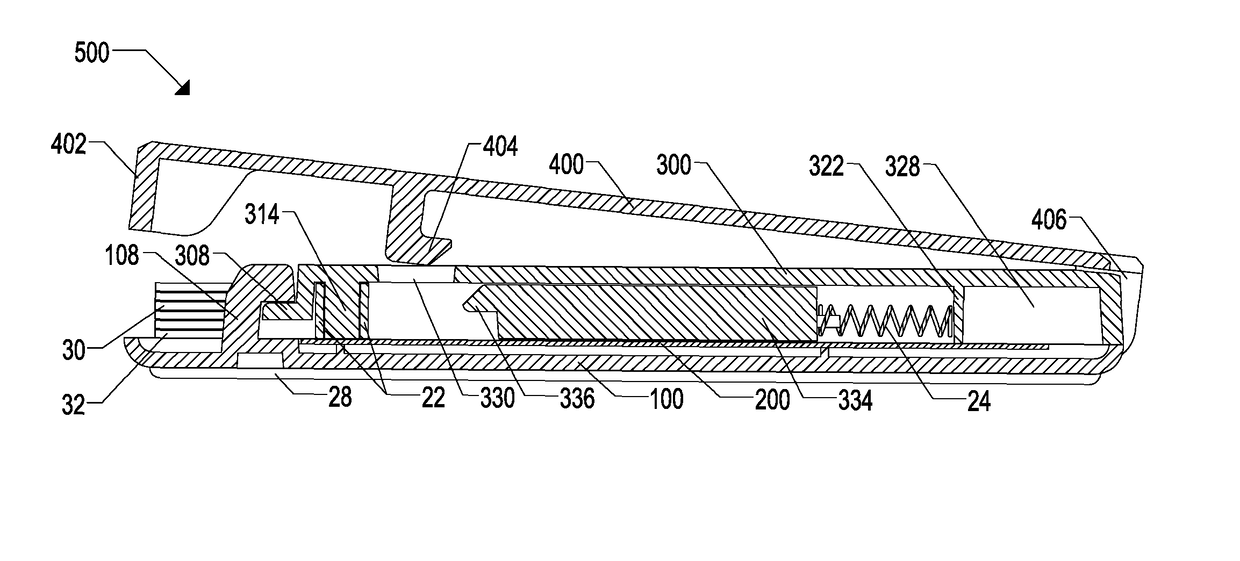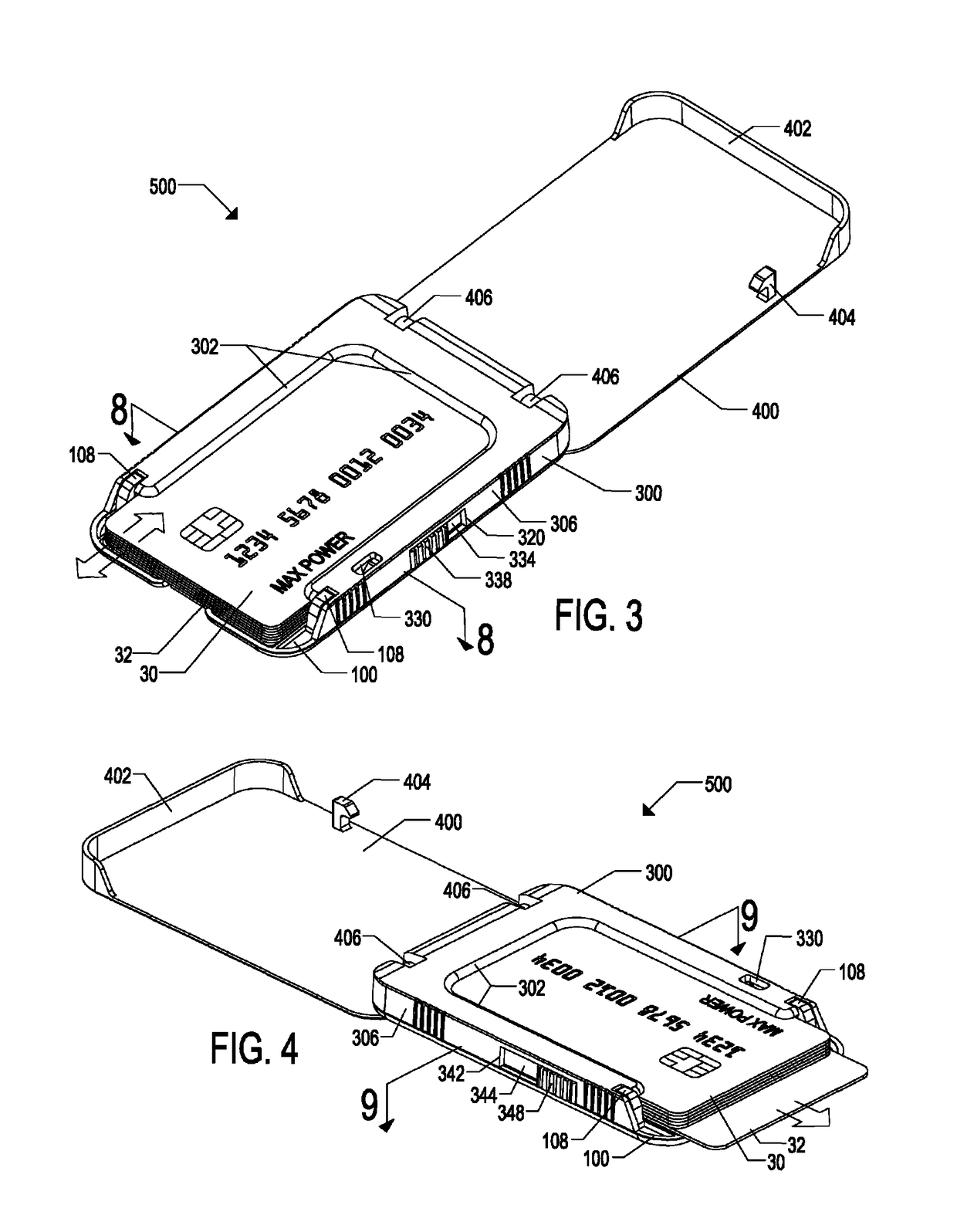In one
scenario, the unauthorized scanning of an RFID enabled card can be accidental, wherein the card owner is unaware that they have come within range of an active RFID reader.
In both of these scenarios, however, the user can no longer take a proactive role in securing information on their cards.
Due to the fragile nature of the microchip that is exposed on these cards, it is not advisable to carry them in a traditional leather or fabric wallet, as the
chip could be easily bent or broken under compressive forces from being in a pocket or bag, and result in malfunction of the card at the terminal.
The issue with these types of card cases and wallets is that there is usually just one card slot, and it is very hard to see or access your cards because most of these cases make you eject cards outwards instead of opening like a traditional bi-fold wallet.
Another big issue with these minimalist card cases and wallets is that they typically utilize a traditional flexible steel or plastic money clip affixed to their exterior that holds paper currency and the like.
These money clips are usually sharp on their edges, have an upstanding lip on the ends, and are bulky and uncomfortable against one's leg while in pocket, sometimes even wearing a hole in a user's pants over time.
The sleeve is meant to be carried in a users pocket or wallet, but this is unfavorable because it adds complication and time to removing RFID cards from a user's wallet.(b) Because of the opaque nature of the electromagnetic-shielding material and its plastic shells, one cannot see through it.
If one skilled in the art were to modify Petsingers card sleeve to hold a plurality of cards, this card retention feature would no longer be effective as the bottom cards underneath the topmost card would have much less friction holding them all in place and risk falling out of the sleeve by accident, as there is no
physical barrier preventing cards from sliding out when the sleeve is not in use.
While it could be said this invention provides a secure RFID shielding
enclosure for a magnetic or contactless smartcard, it has the following flaws:(a) It only holds one card and is not practical by any means as an everyday carry wallet or case.
Osborn's case is thick and oversized for holding just one card inside, and does not teach or describe an additional compartment for paper currency, receipts, or even more cards.(b) If one skilled in the art were to expand the thickness of the case to hold more cards, it would make the case even bulkier, as the insert inside already creates gaps between the cards and the inner surfaces of the case via the polymeric insert.
Moreover, the entire stack of cards would have to be picked up out of the case and sorted through by hand, which is clumsy and unintuitive.(c) The case has an oversized lid that must be popped off and
set aside somewhere to access the lone card inside, adding complication and time for a user trying to pay for an item quickly.(d) There is nowhere to store paper currency or the like.
There are several serious issues with Visa's solution and with other RF shielding wallets that use this same method:(a) These electromagnetic shielding wallets are made to be carried in one's pocket or handbag.
However, while these traditional bi-fold type wallets are in one's pocket or handbag they have a tendency to pivot open slightly as a result of the user walking, running, or being jolted.
When these wallets fold open even the slightest bit, the RF shield liner on the outside of the wallet also spreads open, and a breach is created in the RF
shielding effect of the wallet, making the smartcards prone to accidental or unauthorized scanning.(b) The card pockets within them are not closed off in any way, even when the wallet is folded closed.
Again, as a result of the user walking, running, or being jolted in some way, the smartcards within the wallet are prone to sliding out of the sleeves, and even the slightest
exposure of these smartcards outside of the RF shield liner can risk unauthorized and accidental scanning of the smartcard.(c) The RF shielding liner inside needs to be flexible and is often substantially thin and flimsy, using materials such as
aluminum foil.
As a result of repeatedly folding open and closed with use, and being subjected to various forces while in one's pocket or bag, these RF shielding liners can easily crumple, tear, or crack, which can lead to a creation of a hole or gap in the electromagnetic
shielding effect of the wallet.(d) There is added labor and cost of manufacturing these kinds of wallets.
It is an added cost and step in the manufacturing process that is often reflected in the retail price for these wallets.(e) These traditional leather and fabric wallets will not protect contactless smartcards and
chip and pin cards from compressive forces, and risks breaking the functionality of these types of cards.
Ippolito's solution has the following flaws:(a) There is no
physical barrier to prevent cards from accidentally sliding out if the retention clip wears out over time.(b) There is no way to physically see the topmost card or any card as they are concealed inside the panels.(c) The money clip attached to the back is bulky, potentially sharp and uncomfortable against the leg in pocket.(d) Ippolito does not teach any method of shielding cards inside from RFID scanning(e) The construction style of the case allows the card
insertion end to be open without any wall element spanning across for support, which means the front opening will bow and bend easily under compressive forces and potentially damage cards contained within.
This design has the following flaws:(a) The L shaped brackets of the channel are tapered inwards toward a back stop so that as cards are inserted, cards bow upwards and deform as the side walls of the channels grip them.
However in order to remove cards in this configuration one would have to physically bend the stack of cards upwards so they begin to clear the second stop wall, then pull out and remove the topmost cards one at a time without anything gripping them, which is clumsy and unintuitive.(c) There is no
physical barrier covering the cards on their exposed side, and Storus does not teach one, so cards on that side are prone to unauthorized RFID scanning, and card numbers are visible to others at all times(d) The money clip on back is of the traditional style and made of a resilient
metal such as steel, the edges of which are sharp, hard and uncomfortable against the leg while carrying in pocket.
 Login to View More
Login to View More  Login to View More
Login to View More 


